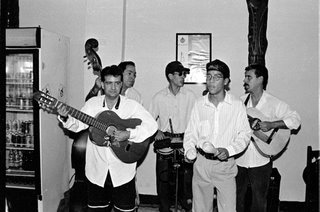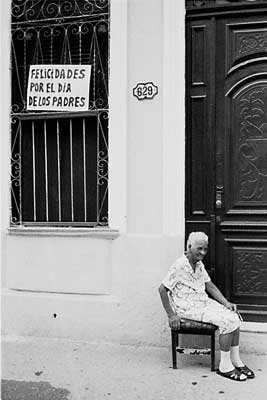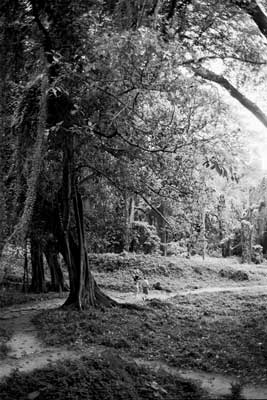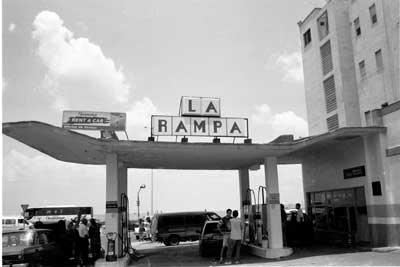 These horse and wagon outfits are very common in many of the towns of Cuba. Here in Ceinfuegoes one finds this arrangement all over the place. People hop on and off, socialize, and all seem perfectly content with the horse drawn wagon as their means of getting about. Needless to say, the gas production exceeds the gas consumption. These vehicles pretty much run on straw and grain. I realize that this is archaic to most of us worldy moderns, but it works and meets the needs of the system. When people don't have big or important jobs, rushing about is much less "important."
These horse and wagon outfits are very common in many of the towns of Cuba. Here in Ceinfuegoes one finds this arrangement all over the place. People hop on and off, socialize, and all seem perfectly content with the horse drawn wagon as their means of getting about. Needless to say, the gas production exceeds the gas consumption. These vehicles pretty much run on straw and grain. I realize that this is archaic to most of us worldy moderns, but it works and meets the needs of the system. When people don't have big or important jobs, rushing about is much less "important."
On the street in Havana you hear the young people greet each other with the phrase, "Que Bola?" this is equivalent to our US slang phrase "What's up?" This Cuba photo blog is morphing into my general blog with a wider scope of photos and commentary.This will enable me to keep my website clean and still have space to babble.
Thursday, June 29, 2006
Local Transportation
 These horse and wagon outfits are very common in many of the towns of Cuba. Here in Ceinfuegoes one finds this arrangement all over the place. People hop on and off, socialize, and all seem perfectly content with the horse drawn wagon as their means of getting about. Needless to say, the gas production exceeds the gas consumption. These vehicles pretty much run on straw and grain. I realize that this is archaic to most of us worldy moderns, but it works and meets the needs of the system. When people don't have big or important jobs, rushing about is much less "important."
These horse and wagon outfits are very common in many of the towns of Cuba. Here in Ceinfuegoes one finds this arrangement all over the place. People hop on and off, socialize, and all seem perfectly content with the horse drawn wagon as their means of getting about. Needless to say, the gas production exceeds the gas consumption. These vehicles pretty much run on straw and grain. I realize that this is archaic to most of us worldy moderns, but it works and meets the needs of the system. When people don't have big or important jobs, rushing about is much less "important."
Sunday, June 25, 2006
CDR in Cienfuegoes
 Cienfuegoes is such a beautiful place it requires color film. Even if like me, you are a total amateur in color, you know you have to do it. The pastels of the buildings are gorgeous. The quaintness of the horse drawn carriages which provide the main form of public transportation add to the charm. They each have a kerosene lantern hanging beneath them so that they can be seen at night. Very much a tourist destination the main drawback are the beggars and scammers. It seems everyone in Cienfuegoes has an angle or a deal for you. I have had business deals proposed by university professors, standard propositions for food, lodging, girls, boys, and cigars. At least when you say "No" most of them leave you alone after that, but it does make it less pleasant. This is hardly a Cuban thing, it occurs throughout out the world, especially the third world and the emerging nations. I have experienced it in Mexico, Puerto Rico, Morocco, and surprisingly in Budapdest. No doubt were I more widely traveled, I would have experienced it elsewhere. None the less, Cienfuegoes is a beautiful city.
Cienfuegoes is such a beautiful place it requires color film. Even if like me, you are a total amateur in color, you know you have to do it. The pastels of the buildings are gorgeous. The quaintness of the horse drawn carriages which provide the main form of public transportation add to the charm. They each have a kerosene lantern hanging beneath them so that they can be seen at night. Very much a tourist destination the main drawback are the beggars and scammers. It seems everyone in Cienfuegoes has an angle or a deal for you. I have had business deals proposed by university professors, standard propositions for food, lodging, girls, boys, and cigars. At least when you say "No" most of them leave you alone after that, but it does make it less pleasant. This is hardly a Cuban thing, it occurs throughout out the world, especially the third world and the emerging nations. I have experienced it in Mexico, Puerto Rico, Morocco, and surprisingly in Budapdest. No doubt were I more widely traveled, I would have experienced it elsewhere. None the less, Cienfuegoes is a beautiful city.
Thursday, June 22, 2006
Pot Calls Kettle Black!
 A school in Miami has taken a book about Cuba from its library at the request of several parents. Apparently the book paints a to favorable picture of a child's life in Cuba and this is against the perception of what Castro has visited upon those people and their island home. No matter how one spins this it is censorship, and it is political censorship, and it is a really dumb thing to do. If one is trying to describe how thought and freedom are suppressed, you hardly help your cause by suppressing a book that doesn't fit your preconvceived notions. One of the first small steps toward fascism is trying to control the flow of information and ideas to the people. It is important to let people, including children, find the truth by themselves. Certainly parents and teachers must help, but practicing censorship is just an object lesson in totalitarianism, The photo above is not a good photo, but it does show the book stalls in Plaza Armas. The book sellers are there several days a week. Most of the books are communist era political treatises and /or history books that recount previous communist glories. Occasionally one finds a book by Marti, a book of poems by N. Guillen, an old Hemingway novel or something like that. These books show the vestiges of control that existed and to some extent still exists in Cuba. Unfortunately, the same thing is sprouting like Kudzu in the United States.
A school in Miami has taken a book about Cuba from its library at the request of several parents. Apparently the book paints a to favorable picture of a child's life in Cuba and this is against the perception of what Castro has visited upon those people and their island home. No matter how one spins this it is censorship, and it is political censorship, and it is a really dumb thing to do. If one is trying to describe how thought and freedom are suppressed, you hardly help your cause by suppressing a book that doesn't fit your preconvceived notions. One of the first small steps toward fascism is trying to control the flow of information and ideas to the people. It is important to let people, including children, find the truth by themselves. Certainly parents and teachers must help, but practicing censorship is just an object lesson in totalitarianism, The photo above is not a good photo, but it does show the book stalls in Plaza Armas. The book sellers are there several days a week. Most of the books are communist era political treatises and /or history books that recount previous communist glories. Occasionally one finds a book by Marti, a book of poems by N. Guillen, an old Hemingway novel or something like that. These books show the vestiges of control that existed and to some extent still exists in Cuba. Unfortunately, the same thing is sprouting like Kudzu in the United States.
Tuesday, June 20, 2006
Playing in the Band
 In this bar on Obispo Street, Lluvia del Oro, or something like that, I encountered this local band. They were all serious music students at the University, several were music teachers on the side, and they really enjoyed playing together. As almost all of these sorts of places open up to the street, the music spills out into the streets at all hours of the day and night, and lends a festive atmsophere. It is always interesting to take a walk in a city in the afternoon and hear someone practicing their music. It seems that the music, unstructured as it might be, wafts freely into the street as a benefit of just being there. More than once , especially in Havana, I have stopped and sat on a wall, the curb, on in an open air café just to listen to someone play and practice their horn or clarinet. The mystery of not knowing exactly who it is and from where it comes, makes it even more fun to do this.
In this bar on Obispo Street, Lluvia del Oro, or something like that, I encountered this local band. They were all serious music students at the University, several were music teachers on the side, and they really enjoyed playing together. As almost all of these sorts of places open up to the street, the music spills out into the streets at all hours of the day and night, and lends a festive atmsophere. It is always interesting to take a walk in a city in the afternoon and hear someone practicing their music. It seems that the music, unstructured as it might be, wafts freely into the street as a benefit of just being there. More than once , especially in Havana, I have stopped and sat on a wall, the curb, on in an open air café just to listen to someone play and practice their horn or clarinet. The mystery of not knowing exactly who it is and from where it comes, makes it even more fun to do this.
Saturday, June 17, 2006
Proud Father
 This man was really proud of his daughter. They had a small business doing a little bit of photography for the neighborhood folks. Both were interested in my camera and wanted to show me some of their work. They seemed to enjoy talking photography, even to a stranger. I must confess that I am rarely treated as a "stranger" while in Havana. Most people have questions about the US, about life there, and it seems they all have a cousin or sibling who lives there. On the Father's Day that I was there a festive atmosphere prevailed as I walked about that afternoon. Lots of music, food being prepared, another important day to celebrate--being happy was the order of the day.
This man was really proud of his daughter. They had a small business doing a little bit of photography for the neighborhood folks. Both were interested in my camera and wanted to show me some of their work. They seemed to enjoy talking photography, even to a stranger. I must confess that I am rarely treated as a "stranger" while in Havana. Most people have questions about the US, about life there, and it seems they all have a cousin or sibling who lives there. On the Father's Day that I was there a festive atmosphere prevailed as I walked about that afternoon. Lots of music, food being prepared, another important day to celebrate--being happy was the order of the day.
Thursday, June 15, 2006
Happy Father's Day
 I was in Havana three years ago for Father's Day. The family where I was staying had a party for me and their father. Each of us got a bottle of good rum, a poem, and a song sung by the children. It was a terrific event. I encountered this lady with her sign on the street several blocks away. Holidays and events like we had are a big part of Cuban life. A poem, a special dessert, children singing a song--these are the things that add real soul to life, the Cubans have that in abundance.
I was in Havana three years ago for Father's Day. The family where I was staying had a party for me and their father. Each of us got a bottle of good rum, a poem, and a song sung by the children. It was a terrific event. I encountered this lady with her sign on the street several blocks away. Holidays and events like we had are a big part of Cuban life. A poem, a special dessert, children singing a song--these are the things that add real soul to life, the Cubans have that in abundance.
Tuesday, June 13, 2006
Che lives!
 This is not a Cuba photo. I took it in Paris several years ago at a parade on the St. Germain de Pres in protest of the bombing of Baghdad. Since then I have photographed people wearing Che tee shirts in all sorts of places from the southeastern US to downtown Budapest. I put it up today to mark the cutting of the power to the US Special Interests Section in Havana. They have recently been broadcasting propaganda and flashing lighted signs with messages that are critical of the government, so the governement simply cut the flow of electricity. The US Special Interests Section is now running on generator power. I think this is symbolic of the embargo. It is a generally bad idea that is losing power as time progresses and it is simply a matter of time. Waiting on Fidel to die will hardly be considered a victory no matter how much spin is applied.
This is not a Cuba photo. I took it in Paris several years ago at a parade on the St. Germain de Pres in protest of the bombing of Baghdad. Since then I have photographed people wearing Che tee shirts in all sorts of places from the southeastern US to downtown Budapest. I put it up today to mark the cutting of the power to the US Special Interests Section in Havana. They have recently been broadcasting propaganda and flashing lighted signs with messages that are critical of the government, so the governement simply cut the flow of electricity. The US Special Interests Section is now running on generator power. I think this is symbolic of the embargo. It is a generally bad idea that is losing power as time progresses and it is simply a matter of time. Waiting on Fidel to die will hardly be considered a victory no matter how much spin is applied.
Sunday, June 11, 2006
Bosque de Habana
 This forested area along the bank of the Almendares river is a gorgeous park. There are large tropical trees, beautiful plants and ferns, and the sound of the river flowing to the sea. As one walks through the park the remnants of Santeria ceremonies and animal sacrifices are encountered. I don't think I would want to be in the park after dark, but in the daytime it is beautiful. Unfortunately it suffers the fate of many nice things in Cuba-no maintenance. It is littered, unclean, and has virtually no facilities for the people. I have missed my annual trip to Cuba this year. First time in 6 years I haven't been there for at least a couple of weeks. When I reflect on how much I miss it, I can't imagine the effect having left Cuba and friends behind would have on oneself. It must be a profoundly deep and painful thing to experience.
This forested area along the bank of the Almendares river is a gorgeous park. There are large tropical trees, beautiful plants and ferns, and the sound of the river flowing to the sea. As one walks through the park the remnants of Santeria ceremonies and animal sacrifices are encountered. I don't think I would want to be in the park after dark, but in the daytime it is beautiful. Unfortunately it suffers the fate of many nice things in Cuba-no maintenance. It is littered, unclean, and has virtually no facilities for the people. I have missed my annual trip to Cuba this year. First time in 6 years I haven't been there for at least a couple of weeks. When I reflect on how much I miss it, I can't imagine the effect having left Cuba and friends behind would have on oneself. It must be a profoundly deep and painful thing to experience.
Thursday, June 08, 2006
Service Station-La Rampa y Malecon
 This service station is at the corner where La Rampa or 23rd Street ends at the Malecon. This area is jammed most nights with young people looking for something to do, somewhere to go, and filled with the ennui of a hot summer night and not much to look forward to. I grew up at the beach and I used to hang out at night around the dance pads and juke boxes adjacent to the sand dunes of South Carolina's coast. Like the Cuban youth we danced, drank beer, and flirted with the girls. Most of us were looking forward to finishing college and having promising careers or jobs. It was a hopeful time, there is little of that in the crowd at the corner of La Rampa and the Malecon most nights.
This service station is at the corner where La Rampa or 23rd Street ends at the Malecon. This area is jammed most nights with young people looking for something to do, somewhere to go, and filled with the ennui of a hot summer night and not much to look forward to. I grew up at the beach and I used to hang out at night around the dance pads and juke boxes adjacent to the sand dunes of South Carolina's coast. Like the Cuban youth we danced, drank beer, and flirted with the girls. Most of us were looking forward to finishing college and having promising careers or jobs. It was a hopeful time, there is little of that in the crowd at the corner of La Rampa and the Malecon most nights.
Tuesday, June 06, 2006
Camello
 These are big hump backed buses pulled by large truck-tractors. The entire rig resembles a camel's back hence the name, camello. They are always jammed full of passengers. Fortunately most of the people are used to lines and crowded conditions, so everyone gets along. According to a friend of mine, if you ride it far enough, you will steal your own stuff back. It only costs a couple of pesos to ride. In the country side, one doesn't encounter buses, you are more apt to see carts pulled by horses, trucks, or wagons towed by old farm tractors. Transportation is one of the larger problems in the country it seems. There is not enough fuel, and there are not enough functional vehicles.
These are big hump backed buses pulled by large truck-tractors. The entire rig resembles a camel's back hence the name, camello. They are always jammed full of passengers. Fortunately most of the people are used to lines and crowded conditions, so everyone gets along. According to a friend of mine, if you ride it far enough, you will steal your own stuff back. It only costs a couple of pesos to ride. In the country side, one doesn't encounter buses, you are more apt to see carts pulled by horses, trucks, or wagons towed by old farm tractors. Transportation is one of the larger problems in the country it seems. There is not enough fuel, and there are not enough functional vehicles.
Subscribe to:
Posts (Atom)